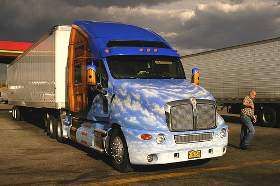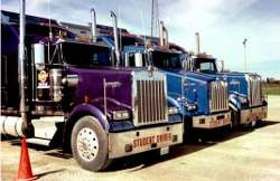First Week...are All Companies Schedules This Tight?
Topic 25309 | Page 1
Your math looks okay to me. Is it a tight schedule? Yes. As for them all being this way at your company, we cannot answer that precisely without more information from you. As you gain time and experience, it will get much easier.

Call your FM and ask if there is a window of time to drop it in. Sometimes they put inaccurate information (sometimes on purpose) for the driver.
Fm:
Dispatcher, Fleet Manager, Driver Manager
The primary person a driver communicates with at his/her company. A dispatcher can play many roles, depending on the company's structure. Dispatchers may assign freight, file requests for home time, relay messages between the driver and management, inform customer service of any delays, change appointment times, and report information to the load planners.I agree with Sid. All you have to do is contact your driver manager/dispatcher. They can usually change it if necessary. Just let them know you dont feel very comfortable with it being so tight. They'd rather adjust it than have one of their drivers on the naughty list for being late.
Dispatcher:
Dispatcher, Fleet Manager, Driver Manager
The primary person a driver communicates with at his/her company. A dispatcher can play many roles, depending on the company's structure. Dispatchers may assign freight, file requests for home time, relay messages between the driver and management, inform customer service of any delays, change appointment times, and report information to the load planners.Driver Manager:
Dispatcher, Fleet Manager, Driver Manager
The primary person a driver communicates with at his/her company. A dispatcher can play many roles, depending on the company's structure. Dispatchers may assign freight, file requests for home time, relay messages between the driver and management, inform customer service of any delays, change appointment times, and report information to the load planners.
Not sure what else to add in. I'm trying to be descriptive without putting possibly unflattering info out there about my company....
Unless your company requires a set amount of time per task, you can tighten up a bit on your fueling and underway stops. 1 minute for every 10 gals is standard to fuel. I never log more than 10-12 minutes to fuel. You can also shorten your underway check to 5 mins or so. Again, this depends on your company's policy on such matters. As long as you log enough time to satisfy your company and DOT , you'll be fine.
DOT:
Department Of Transportation
A department of the federal executive branch responsible for the national highways and for railroad and airline safety. It also manages Amtrak, the national railroad system, and the Coast Guard.
State and Federal DOT Officers are responsible for commercial vehicle enforcement. "The truck police" you could call them.
How heavy are you and where are you running?
The 50 mph is good for planning, but unless you are stopping to use the bathroom a lot you should avg above 50. If you avg a 55 mph transit than you only need 14.75 hours drive time.
At face value that run looks tight, but if you're able to push you will find you have plenty of time.
Why are you fueling twice on an 800 mile run?
TWIC:
Transportation Worker Identification Credential
Truck drivers who regularly pick up from or deliver to the shipping ports will often be required to carry a TWIC card.
Your TWIC is a tamper-resistant biometric card which acts as both your identification in secure areas, as well as an indicator of you having passed the necessary security clearance. TWIC cards are valid for five years. The issuance of TWIC cards is overseen by the Transportation Security Administration and the Department of Homeland Security.
Wondering why two fuel stops for an 800 mile trip?

Thanks Turtle I'll try to watch the clock a bit more. I'm more accustomed to prioritizing thorough over quick in my old career, and it seems like with the consequences of missing something here in this job...I'm getting paid for safe professional miles. Adding the scheduling stress is, well, maybe counter productive...??

Yeah not sure why the fuel stops- I'm given a specific route and specific fueling stops/qty. Some of the routing makes sense, tolls etc, but some of it looks frankly stupid. But I don't pay tolls or fuel and they pay every mile, so I'm not complaining....except about the down-to-the-minute bit. I could do without that....
New Reply:
New! Check out our help videos for a better understanding of our forum features

















Preview:
This topic has the following tags:
Advice For New Truck Drivers Life On The Road Time Management Trip Planning







 TT On Facebook
TT On Facebook
My latest load is 808 miles from shipper at 10am EST to receiver at 1300 CST is 27 hours plus 1 more for time zone.
if I'm understanding my numbers, using the 50mph we are told to use I'm at just over 16 hours drive time. Thus a 10 hour break. So I'm at 26 (16 drive+10 off duty/sb). First day I'm thinking a 15 min pre trip on the trailer I'm picking up and a 15 min underway check plus the fuel stop for 30 min so I have let's say 8 hours drive, 1 hour on duty not driving. 9 hours. then 10 off duty brings me to the next morning. Another 15 min pre trip, another 15 min underway check, another 30 min fuel stop. Plus the rest of the drive- 8 hours. Total is 28 hours. Exactly what I have.
Except that now, if I'm correct, if I need to stop, use the bathroom, or anything not accounted for.....I'll be late.
This makes no sense to me.... What am I missing?
Shipper:
The customer who is shipping the freight. This is where the driver will pick up a load and then deliver it to the receiver or consignee.